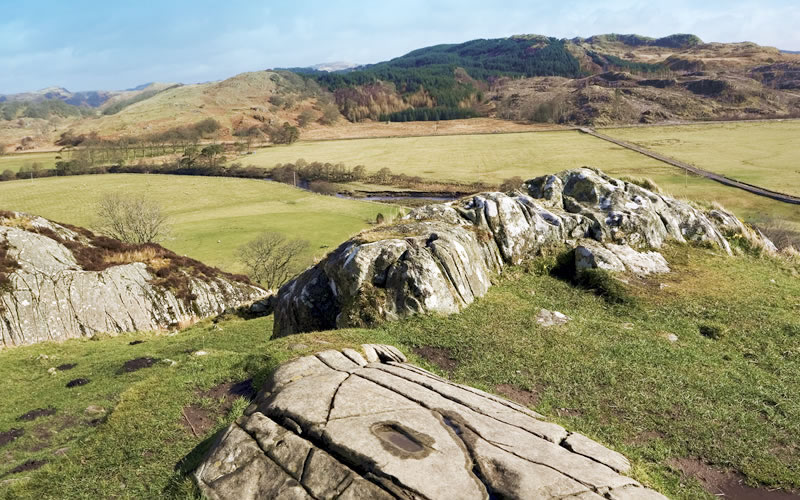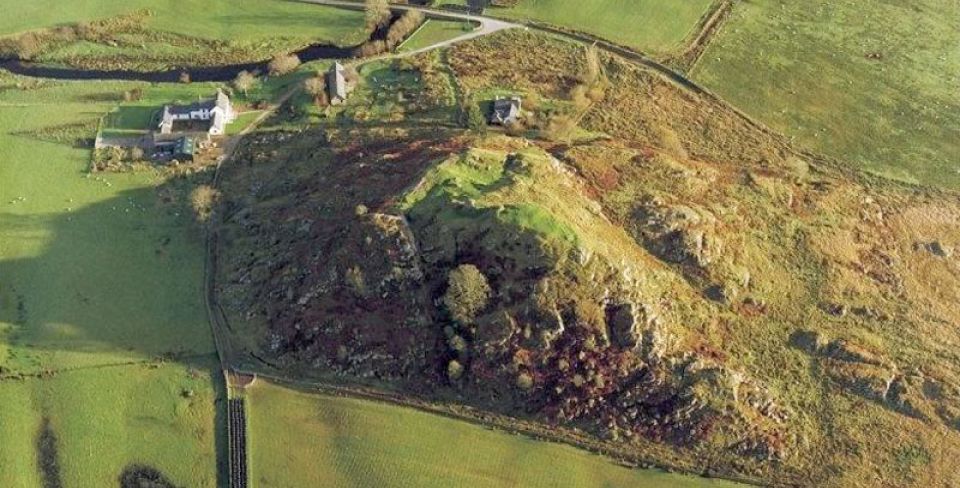6.1 Dunadd
In the 6th century Dunadd was the power base and main fort of the local rulers – the Dál Riata.
This rocky outcrop stands high on the Moine Mhor Great Moss with the River Add weaving around its base.
Colmcille is thought to have visited the king of the Dál Riata at Dunadd when he first arrived in Argyll.
Visit the rocky outcrop where the Dál Riata had their fort. Discover the footprints carved in stone which were part of a Dál Riata royal ritual dating back to the 5th century.
Not long after he arrived in Argyll, Colmcille is said to have visited king Conall, ruler of the Dál Riata, at his main settlement.
Dunadd was Conall’s chief fort and power base so Colmcille is likely to have come here.
The Dál Riata had lands spreading across parts of present day Northern Ireland and Argyll.
It is possible that Conall granted Colmcille permission to build a monastery on the island of Iona and later to his extend his network to other islands in the Hebrides.
The massive fort of Dunadd was built on a rocky outcrop rising 60 metres from the surrounding land.
From the hill you can see the harbour at Crinan, about 3 miles away and, across the sea, the islands of Jura and Scarba. It is easy to see why this strategic site was used and developed over many centuries.
The fort was expanded over many generations – starting with a small dun in the 4th or 5th century and still being developed into the 8th or 9th century. At one time, the walls here were 10 metres thick.
Climb up the hill to find two footprints carved into a rock near the summit. These footprints were part of the inauguration ceremonies of the kings of Dál Riata.
Colmcille is said to have taken part in the inauguration ceremony of King Aidan here at Dunaddd in 574.
A footprint carved in the rock faces north. Tradition says that this is the footprint of Oisin or Fergus Mor Mac Erca, the first King of Dál Riata who died in 501. A second footprint is incomplete.
There is a carved image of boar nearby, now very faint, and an inscription written in ogham – an early medieval alphabet. The letters consist of angled scratches made in the rock. It is not clear what the carvings mean but they show that the fort was a special place, linked with powerful people.
The original stone now lies underneath a composite stone replica so that the original carvings are protected.

The basin carved into the rock was probably used to hold water during inauguration ceremonies.
The Dál Riata made beautiful jewellery and stone carvings. Their settlement at Dunadd was a centre of learning and culture as well as a military and political base.
Archaeological digs on this site have revealed that the Dál Riata were trading with people from mainland Europe. Archaeologists unearthed a rich collection of pottery imported from the continent. The pottery is the largest collection ever found in any Celtic country on the west coast of Europe.
The Dál Riata also made their own jewellery such as broaches and pins. Excavations have unearthed the moulds in which these valuable objects were made.
Objects found here at Dunadd are now housed in the Kilmartin Museum and the National Museum of Scotland in Edinburgh.
Argyll was probably already Christian when Colmcille arrived in 563. The earliest Christian monuments found here date from the 6th century.
The area has many early Christian carved stones and sites connected with worship.
These can be found in Kilmartin Parish Church , Kilmichael Parish Church, Kilmory Knap Chapel and Keills Chapel.
Argyll
- 6.1 Dunadd
In the 6th century Dunadd was the power base and main fort of the local rulers - the Dál Riata. This rocky outcrop stands high on the Moine Mhor Great Moss with the River Add weaving around its base. Colmcille is thought to have visited the king of the Dál Riata at...
- 6.2 Kilmartin House Museum
Kilmartin House Museum is housed in the former manse of Kilmartin Church at the centre of Kilmartin village. Kilmartin Glen has an extraordinarily rich collection of 350 ancient monuments, all found within a six-mile radius of the museum. The area has a strong early Christian history and is closely connected to the...
- 6.3 Kilmartin Church
Kilmartin Glen is the site of more than 350 ancient monuments. These sites - which include 150 prehistoric monuments - lie within a six-mile radius of Kilmartin village. Yet this area has also played an important role in Scotland’s early Christian heritage. Just 5 miles south of here at Dunadd, the...
- 6.4 Keills Chapel & Graveyard, Keillmore
Keills Chapel sits up on a peninsular stretching out along the west side of Loch Sween. It dates from the 13th century but it is thought that people began worshipping here in the 8th century. As with Kilmory Knap Chapel across Loch Sween, this chapel does not have a direct link to...
- 6.5 Kilmory Knap Chapel
The chapel of St Mary at Kilmory Knap is on the east side of Loch Sween. Kilmory means 'the Church of (St) Mary'. From here there are clear views across to the island of Islay and Jura. It was built in the first half of the 13th century and now houses...
- 6.6 Cholmcille’s Chapel & Cave, Ellary
This peaceful location on the shores of Loch Caolisport is said to be where Colmcille stopped for a few days on his journey north from Ireland in 563. He was seeking a meeting with the local king, Conall mac Comgall, whose chief fort was about 15 miles from here at Dunadd....
- 6.7 Southend
Southend is said to be Colmcille’s first landing place in Scotland. He left Derry on the north coast of Ireland in 563 with 12 companions and landed here before heading up the Argyll coast to meet the king of the Dál Riata. On a small mound to the west of...










Bòrd na Gàidhlig
Great Glen House
Leachkin Road
Inverness
Scotland, IV3 8NW
(+44) 01463 225454
colmcille@gaidhlig.scot
Colmcille
Foras na Gaeilge, 2-6 Queen Street
Belfast
Northern Ireland
BT1 6ED
(+44) 028 9089 0970
colmcille@forasnagaeilge.ie
Colmcille
Foras na Gaeilge, An Chrannóg
Na Doirí Beaga
Gaoth Dobhair
Donegal, Ireland. F92 EYT3
(+353) 074 9560113
colmcille@forasnagaeilge.ie


